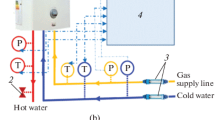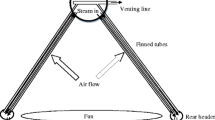Abstract
In the present study, the effects of fin thickness on the heat transfer and friction characteristics of fin-and-tube heat exchangers having herringbone wavy fin configuration are experimentally investigated. The experimental apparatus consists essentially of a well insulated open wind tunnel and herringbone wavy fin-and-tube heat exchangers made from aluminium plate finned, copper tube. Air and water are used to be working fluids in air-side and tube-side, respectively. A total of 10 samples of the fin-and-tube heat exchangers are tested. The experimental procedures are conducted by keeping the inlet water temperature at a pre-selected value, adjusting the water volumetric flow rate at a specific value and varying the air velocity. The results are presented as plots of the Colburn factor and friction factor against the Reynolds number based on the fin collar outside diameter (Re Dc ). From the results, it is found that for number of tube rows (N) = 2, the Colburn factor increases with increasing fin thickness. For N ≥ 4, the Colburn factor decreases with increasing fin thickness when Re Dc < 1800, and increases with increasing fin thickness when Re Dc > 2500. The friction factor increases with increasing fin thickness when fin pitch (F p ) ≤ 1.81 mm.








Similar content being viewed by others
References
Beecher DT; Fagan TJ (1987) Effects of fin Pattern on the air-side heat transfer coefficient in plate finned-tube heat exchanger. ASHRAE Trans 93(2): 1961–1984
Wang CC; Fu WL; Chang CT (1997) Heat transfer and friction characteristics of typical wavy fin-and-tube heat exchangers. Exp Therm Fluid Sci 14(2): 174–186
Wang CC; Tsi YM; Lu DC (1998) A comprehensive study of convex-louver and wavy fin-and-tube heat exchangers. AIAA J Thermophys Heat Transfer 12(3): 423–430
Wang CC, Lin YT, Lee CJ (1999) Investigation of wavy fin-and tube heat exchangers: a contribution to databank. Exp Heat Transfer 12: 73–89
Yan WM; Sheen PJ (2000) Heat transfer and friction characteristic of fin-and tube heat exchangers, Int J Heat and Mass Transfer 43: 1651–1659
Wang CC; Chang YJ; Hsieh YC; Lin YT (1996) Sensible heat and friction characteristics of plate fin-and-tube heat exchangers having plane fins. Int J Refrigeration 19(4): 223–230
Wang CC; Lee WS; Sheu WJ (2001) A comparative study of compact enhanced fin-and-tube heat exchangers. Int J Heat and Mass Transfer 44: 3565–3573
Wang CC; Hwang YM; Lin YT (2002) Empirical correlations for heat transfer and flow friction characteristics of herringbone wavy fin-and-tube heat exchangers. Int J Refrig 25: 673–680
Spalding DB; Taborek J (1983) Heat exchanger design handbook, part 1 heat exchanger theory. Hemisphere Publishing Corporation, pp 1.5.1-1–1.5.3-13
Gnielinski V (1976) New equation for heat and mass transfer in turbulent pipe and channel flow. Int Chem Eng 16: 359–368
Schmidt ThE (1949) Heat transfer calculations for extended surface. Refrig Eng 351–357
Kays WM; London A (1984) Compact Heat Exchangers, 3d ed., McGraw-Hill, New York
Acknowledgements
The present study was financially supported by the Joint Graduate School of Energy and Environment (JGSEE) and the Thailand Research Fund (TRF) whose guidance and assistance are gratefully acknowledged. The authors wish to acknowledge Mr. Kreangsak Aowphol for his assistance in some of the experimental work and Mr. Panya Pitawanik from the Thai Heat Exchange Company for valuable donation of the fin-and-tube heat exchangers.
Author information
Authors and Affiliations
Corresponding author
Rights and permissions
About this article
Cite this article
Wongwises, S., Chokeman, Y. Effect of fin thickness on air-side performance of herringbone wavy fin-and-tube heat exchangers. Heat Mass Transfer 41, 147–154 (2004). https://doi.org/10.1007/s00231-004-0507-7
Received:
Published:
Issue Date:
DOI: https://doi.org/10.1007/s00231-004-0507-7




